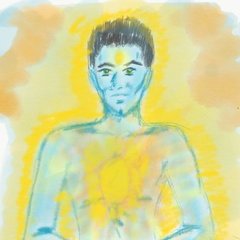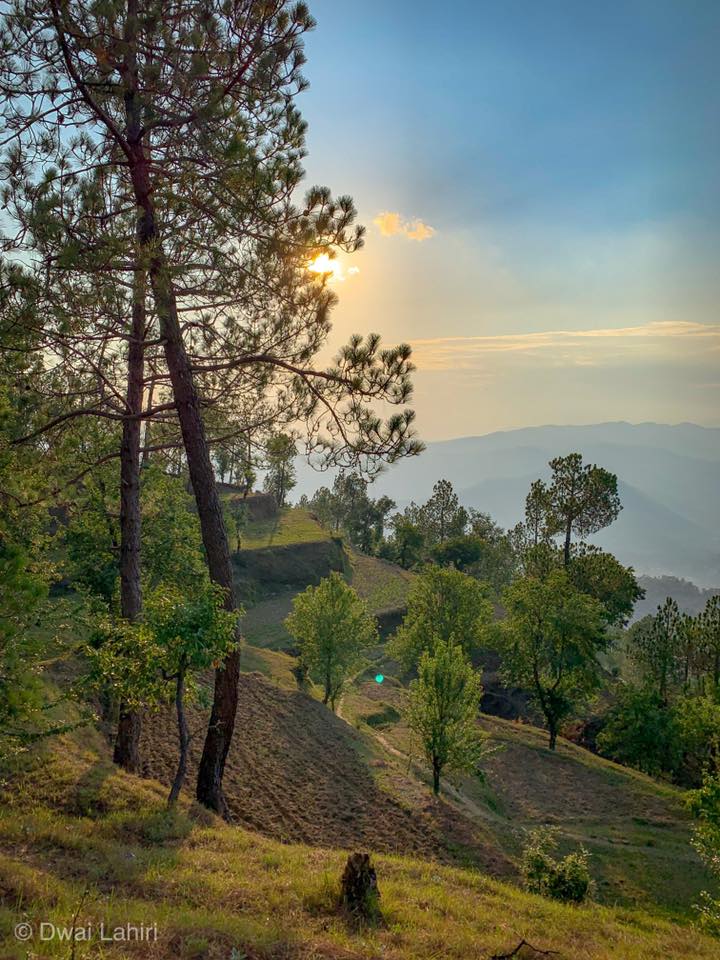-
Content count
8,286 -
Joined
-
Last visited
-
Days Won
70
Everything posted by dwai
-
beautifully said my friend!
-
You are absolutely right. All DO does is show that phenomena are devoid of self-existence. It is really that simple...it also states that any attempt to show either extreme of any duality as being absolute will lead to contradiction and confusion (prasanga aka reductio ad absurdum). The difference between the Western concept of Reductio ad absurdum and Prasanga is that the former is employed to dismantle one side of an argument where as in the Madhyamika paradigm it is used to dismantle all sides of any argument/debate. But underlying the obvious implication is the understanding (which rises from intuition or prajna) that that emptiness is the medium and source of all phenomena (and all duality as a result thereof). It is very good that your bring the "thought-form vs reality" concept...I think Dr. Rama's book on Jnana Yoga very succinctly and elegantly demonstrates that. And also, to expand on that, thought-form also has it's place in reality since it exists, since it has a name and form in the time domain. But relative to the existence of something which has name and form in both space and time domains, it is "unreal".
-
Actually it is perfectly valid to use Turiya because this is not a state some people experience and others don't, but rather it is a state that every one CAN experience if they follow certain practices. It is critical in the phenomenological inquiry process to be able to access this state. It is jargon for those who are not versed in the paradigm of Advaita and Yoga. The paper was meant for people with background knowledge in at least one of them (and possibly both). I think it is faulty to read a qualitative judgement into the views articulated by Dr. Rama. If you are versed in the philosophical background of the two systems (Advaita Vedanta and Buddhism), which in your case you obviously are, then it is nothing but a re-iteration, summarization of the practicing principles of these systems. The demarcation between Pure objectless Consciousness and Consciousness with Object is essential for two reasons: a) to realize that consciousness exists without objects...in that it is self-existent and not dependent on objects (ie beyond duality) and to show that the concept of the two-levels of existence/truth/reality (the relative aka samvritti or vyavaharika satya and absolute or paramartha satya) are validated, re-affirmed via this medium. I see you make the mistake of assuming that by categorizing consciousness in the traditional manner, he somehow qualitatively dismisses the consciousness with objects. That could be (and usually is) a very standard psychological reaction when encountering this system. This psychology leads to misplaced notions of superiority and inferiority. The truth of the matter however is that there is no such thing because they are a continuum and any demarcation between the two is a matter of necessity (to effectively impart the knowledge). It is like night and day being two distinct states...and saying that night is worse than day somehow. The fact is that night and day are part of a continuum of less light and more light (which come with their own implications of course) and any distinction between the two is a phenomenological statement of observation (empirical) as opposed to articulation of any absolute stand or position.
-
It is seeded in deep insecurity and a need to stand out in a crowd usually...those who know do not tell those tell do not know (old saying)
-
The two go together, no? The physical and the mental i mean...why separate that which is one? Mind and body are not two but one
-
Now, I'm not an American though I live here. I am Indian and tend to resonate with the Indian paradigm. But my quest is for that one...so I practice Advaita (Non-Dualism) with a mix of Jnana and Bhakti (Knowledge and Devotion) Yoga. I practice Tamil Siddhar Yoga and associated Kriyas, Arupa (Formless) Meditation, also practice Taoist Tai Chi Chuan and related Tao Gong meditation. Also I find this demarcation between "Physical" and "Mental" enlightenment very interesting (albeit a tad baffling). Why does there need to exist this cartesian chasm? That which is (Enlightenment if one so chooses to call it) is felt in both mind and body because then there is no mind and no body, but there is only that one (Tad Ekam)!
-

The worlds greatest martial art is ..............
dwai replied to mewtwo's topic in General Discussion
funny...I was just going to post "The Art of fiding widout fiding" Then I read your post... Cheers! -
I think Greg Goode is getting stuck in semantics instead of experience. That's the problem with most folks...to much theory, not so much experience.
-
I think these are over-hyped and over-understood by many. The beauty of their insight lies in the simplicity. Human beings (especially modern humans) are too used to thinking in convoluted patterns to understand the simplicity, imho.
-
That's the opinion of two authors...
-

Opening from the Heart and the Wrong Approach to Non-Duality
dwai replied to Lucky7Strikes's topic in General Discussion
Gee! You're beginning to sound more and more like someone else I know.... Hey waitaminnit! Me!! -
I assume there is a point here...just not sure what it is. Please elaborate....
-

Opening from the Heart and the Wrong Approach to Non-Duality
dwai replied to Lucky7Strikes's topic in General Discussion
Nagaruna 101. Very nice and insightful...read the post titled "Nagarjuna and Samkara, Some reflective thoughts" and the link provided there in...this will take our "old debates" a long way further. -

Opening from the Heart and the Wrong Approach to Non-Duality
dwai replied to Lucky7Strikes's topic in General Discussion
You're getting there, imho. The proverbial boat has sailed from the river to the ocean now...the key is to not get caught in a reverse current and float back into the river. -
I've been researching the CTMAA school in Skokie, IL myself for a while now. And their take seems very intriguing. The style of Taiji I learn is Master Waysun Liao's Temple-style (very CMC-esque), but with heavy focus on single form practice (the long form is a tool to ensure that we can retain the flow through transitions). In our school too, the emphasis is on returning the power from the earth (so the opponent's power goes down the bone structure and returns via the connective tissue). But the precursor to doing power transfers is to practice Condensation breathing, where we condense the Qi into the bone marrow. I also recently discovered Master William CC Chen's (via Rick Barrett's book titled "Taiji Quan through the Western Gate") mechanism of the Three-nails. I have incorporated that into my practice and can tell you that it makes a genuine, palpable difference in both the physical as well the energetic structure of the practice. The legs are (as I discovered and so I've been told) the hardest to develop sensitivity and flow in. After incorporating the 3-nails method, I have seen distinct and clear difference in the quality of flow (which was there before, but not as refined). I suspect that the "Pre-heaven method" is very much in line with the 3-nails method, since in the latter, the ball of the feet is where power is generated/issued from. According to Master Chen (from what I have understood), the dan tien is regulator, but the feet are the generator. Without using the Dan Tien, we cannot direct the power, but without using the feet, we cannot return the power effectively. http://www.williamccchen.com/3nails.htm
-
Yes...there are specific practices that can be used to modify and alter the material realm (spontaneous manifestation, being in two places at the same time, etc). If you go to the South of India, there is a very active (but secretive) practice of these systems...it is called Bhanumati. Look in the region of Southern Karnataka (South-Western coastal areas primarily) and Kerala.
-

how to tell prana from kundalini up the shushumna and meditation numbness?
dwai replied to mewtwo's topic in General Discussion
I think there's a lot of over-glamourization of the Kundalini experience, primarily by people who weren't prepared but managed to awaken it. What you are feeling is the energy rising up the spine, of which Kundalini is another aspect. There is not separate "Kundalini" and "Prana", they are one and the same. Depending on what part of the body this Prana (Chi) energy is flowing, it is variously called Prana, Apana, Vyana, Samana and Udana. -
Er....how is the "Extra-ordinary claims calls for extra-ordinary evidence" logic applicable to this? Everyone experiences a "self". Buddhists go a long way to claim there is "No Self". With that locus standii in mind, the extra-ordinary claim is made by the buddhists and not vice versa. Therefore the onus is on the buddhists to prove that there is indeed no Self. I really don't want to re-re-re-hash the drivel we've been throwing at each other pretending to be "spiritual" discussion in this thread. Lucky, I acknowledge your apology. I repeat my position that one day you will understand what I was trying to convey. The proof of the pudding is in eating it...so bon apetit!
-
It seems jargon to you because you are not familiar with the system and the language (that's also my problem with most things, even in Taiji practice for instance). But really they are concepts...and independent of the syntax, they convey certain knowledge. Knowing that is more important than the jargon. Mudras are very interesting, because as you are already aware, there are many mudras. And each work on specific meridians or specific "doshas" (per Ayurvedic medical system, there are predominantly three doshas or humors, the wind (Vata), water (Kapha) and Fire (Pitta)). The mudras I was referring to are for Yogic/pranayama practice only. And they serve one of two purposes...to close or activate a circuit (eg: tongue pressing into upper palate will complete the microcosmic orbit) or to connect certain body locks (bandhas -- perenium lock, plexus lock, chin lock) to certain hand gestures. When used during asana (yoga pose) or pranayam (breathing), they will move the energy into or direct the energy into certain channels.
-
Ah i see! I would recommend you delve into theory of seed sounds if you want to investigae into the mantras. Why? Because as you rightly recognized every sound has an ewnergetic signature. In sanskrit language the 50 syllables have very specific ewnergetic values and affect specific parts of the human complex. There are different types of mantras....seedless, with-seed. Of the seed mantras used in tantra and specificw vedic applicatons the majority affect chakras directly. Of the othrr types of mantras there are spcific metres ( rythms) called chchandas which are needed to learn proper expression an practice. For eg, the gayatri mantra (perhaps the most popular mantra among hindus) is in the gayatri metre. There are other metres and these define the pronunciation of the sounds, where to extend a syllable, when to stop abruptly etc... If a mantra is not practiced along the rules that make it active, it becomes ineffective. So yes, mantras will have a diret energetic impact on the practitioner, provided they practice correctly... In the same line, if someond decides to use their own words as mantra, say "oh mommy take me home" instead of "om mani padme hum" the odds of their practice bearing fruit are as likely as of pigs growing wings and flying


